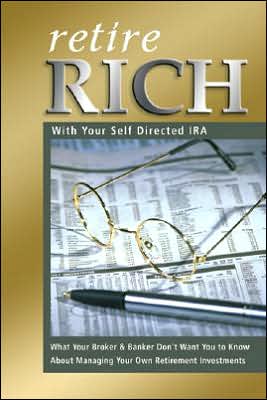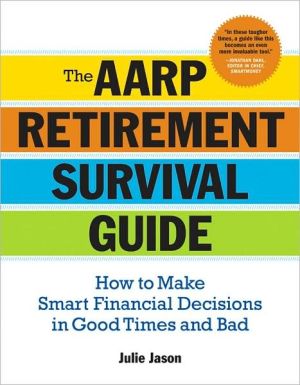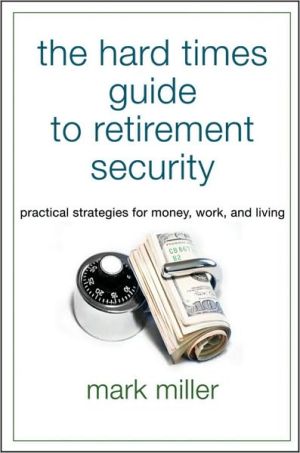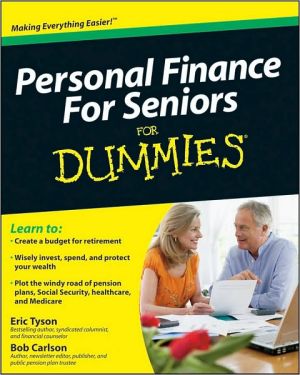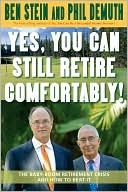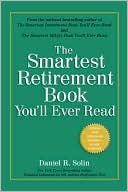Retire Rich with Your Self-Directed IRA: What Your Broker and Banker Don't Want You to Know about Managing Your Own Retirement Investments
In recent years many smart investors have exited the stock market because they have essentially lost control of their investments. They have relied on the advice and skill of their brokers, bankers, and financial advisors. Many retirement accounts have dwindled or not increased. Fortunately, there is a great but little-understood alternative: the self-directed IRA. This new book will teach you how to turn your IRA into a wealth-building tool that you control 100%! Take control of your...
Search in google:
In recent years many smart investors have exited the stock market because they have essentially lost control of their investments. They have relied on the advice and skill of their brokers, bankers, and financial advisors. Many retirement accounts have dwindled or not increased. Fortunately, there is a great but little-understood alternative: the self-directed IRA. This new book will teach you how to turn your IRA into a wealth-building tool that you control 100%! Take control of your investment future, and make sure your investments are performing for YOU, not someone else. Why haven t your banker and broker ever told you about this new IRA? Because they will no longer make any money on your retirement account! New IRS regulations and the new self-directed IRA make it effortless to build up and keep hold of IRA money. Inside this new book you ll find out how to benefit from the new IRS rules and how to stay away from problems. With a self-directed IRA you can purchase real estate, buy a business or franchise, invest in high-yield mortgages and notes, invest in tax liens and foreclosed homes, manage property purchased by your retirement, rental property, ocean-front property, lake-front property, probate property, commercial property, REO property, tax-lien property, repossessed property, foreclosed property, apartment communities, and storage facilities. You can invest in stocks, bonds, mutual funds, or virtually any investment allowed by IRS regulations. The self-directed IRA lets you act as your own investment manager. We will show you how to set up your account with a custodian or IRA administrator to deal with the day-to-day activities, such as depositing contributions and executing and settling investment transactions. It s easy, fun, and puts you back in control of your retirement account. Retire Rich with Your Self-Directed IRA combines essentials, insight, and insider secrets to secure a financial victory after retirement. **Award-Winning Finalist**
RETIRE RICH With Your Self-Directed IRA\ What Your Broker & Banker Don't Want You to Know About Managing Your Own Retirement Investments \ \ By Nora Peterson \ Atlantic Publishing Group, Inc.\ Copyright © 2006 Atlantic Publishing Group, Inc.\ All right reserved.\ ISBN: 0-910627-72-X \ \ \ Chapter One\ EXTREME MAKEOVER-RETIREMENT STYLE \ I am opposed to millionaires, but it would be dangerous to offer me the position. -Mark Twain\ Meet Joanne Moneymaker -Jo, for short. Jo is not much different from you or me. She might be a little older. Or she might be a little younger. She might earn a little bit more than you. Or she might earn a little less. Still, her goals for retirement are very similar to your own. She wants to accumulate sufficient assets to secure a comfortable and worry-free retirement.\ For the past 12 years, Jo worked as a budget analyst for a Fortune 1000 homebuilder that specializes in developing resort-style retirement communities. That was until she lost her job when the company reorganized and downsized.\ Jo was lucky; she landed on her feet with a better job. Her new position with a startup construction business pays more and offers her a better career path than the old company. The only problem in her life right now is the $200,000 question: What to do with the funds in her former employer's retirement plan. It doesn't sound like a terribly difficult decision on the surface, but the laws governing retirement savings are complex, and thereare very few do-overs where the IRS is concerned, so Jo wants to consider her options carefully.\ WHEN OPPORTUNITY KNOCKS ...\ Sometimes life's blessings come disguised as a kick in the pants. So it was with Jo. It's just that she was having a hard time recognizing it, as she sat at her desk reading and re-reading the small mountain of paperwork she had been handed, along with that ugly little pink slip that thanked her for her service and wished her well in her future endeavors. Each sheet of paper seemed to demand one more decision from her, and the one outlining what she had to with her 401(k) had her completely stumped.\ Several friends had told her to roll it into the 401(k) with her new employer. Another told her to roll it into a Roth IRA. None could explain why one recommendation was better than the other. One thing she knew for sure was that her clock was ticking.\ The company's policy gave her a deadline for submitting rollover paperwork, or they would write her a check for the balance in her account. With only a month to go before her deadline, Jo had pretty much decided that rolling one 401(k) into another 401(k) seemed like the simplest and most logical answer.\ As luck would have it, a telephone call from an old college buddy saved her from making that mistake. After laying out her dilemma yet one more time, the friend gave her the name of a certified financial planner. Two days later, Jo was sitting across a conference table from Bill Cash. Going to see Bill may turn out to be the smartest financial move she will ever make.\ A HOUSE MADE OF STRAW\ Until Jo met Bill Cash, she operated under the mistaken belief that she had her financial house in tip-top shape. Through her work, she'd had ample opportunity to see that some people retire well and others not so well. As a result, Jo decided early on that, when her turn to retire comes along, she would be counted among the former.\ Jo has given serious thought to how much money she will need to have put aside when she retires. Even though her goals are modest, she figures she'll still need a sizable nest egg to ensure that she can, at the very least, maintain her current lifestyle. With a little good fortune, she might even have enough money to do some of the things that people promise they'll do when a job is no longer the centerpiece of their daily lives. Her plan was basic but aggressive.\ SAVE EARLY AND OFTEN\ Jo understands the power of compound growth. It was a lesson her parents taught her when she was eight years old. At that time, she received a $10 weekly allowance. They required that she save 20 percent of it. Each week, she put $2 into a cookie tin. At the end of each month, she counted it out with her father, and he paid her 10 percent compound interest on the balance. The first interest payment of seven cents failed to generate much excitement on her part, but the next month her father paid the interest in nickels and dimes. Within a few months, he was paying her the interest in quarters and then in dollar bills. The longer she left her money in the cookie tin, the faster the balance grew. The experience made a believer out of her. Before long, she voluntarily started dropping $3 a week into the box and, as her father periodically increased her allowance, she voluntarily increased the portion she saved.\ It worked then and it has worked for the 12 years since Jo landed her first job and opened an IRA account. From the beginning, she has contributed the maximum the IRS allowed, which means that her early contributions amounted to $2,000 a year and increased to $3,000 in 2004 and then to $4,000 in 2005. During the same period of time, Jo also maxed out her contributions to her company's 401(k) plan. Her employer's savings-incentive policy, which matched her contributions dollar for dollar, combined with the returns on her investments, has kept her balance steadily growing, and Jo is optimistic about her financial future.\ TIMING IS EVERYTHING\ Jo does one more thing to give her IRA balance an extra boost. She makes it a January 1 ritual to write the check for her IRA, instead of waiting until the end of the year like her brother, Ted, typically does. Even though they started their accounts in the same year and have contributed exactly the same amounts to them, Jo's account has earned hundreds of dollars more than Ted's. Part of that difference can be attributed to her investment choices, but even if we assume that she and Ted earned the same 8 percent return on their IRA accounts, Table 1 on the following page clearly shows that a small decision about timing can yield a big bonus on a year-after-year basis. In 2005 alone, Jo's $4,000 New Year's contribution earned her $332 by the time her brother got around to making his own IRA contribution.\ The difference in their earnings is even more dramatic, if we look at what happens to their balances over the course of 20 years. If Jo and Ted continue their contribution patterns for the next two decades, Jo will earn a full $18,644 more than her brother, just by choosing to make her deposit at the beginning of each year instead of at the end of it. The difference would be even greater if Ted waited until the following April 15, as the IRS allows.\ DIVERSIFY HOLDINGS\ To Jo, investing all of your money in one stock or class of stocks would be as foolish as jumping out of a perfectly good airplane. She's not that kind of risk taker. At the same time, she recognizes that without risk, there is little reward. She balances that risk-reward relationship by using an asset-allocation strategy that makes certain her investments are as diversified as the administrators of her 401(k) and IRA accounts permit, which basically means that she primarily owns stock, index funds, and mutual funds in her retirement accounts. She limits her holdings in her employer's stock to no more than 10 percent of her total 401(k) portfolio, so that if the company hits on hard times, she won't lose both her income and her future security.\ Outside her retirement accounts, Jo has been busy building assets also. She owns her home, a handful of stocks and index funds, some gold coins, and a few other small investments. Until recently, she'd owned a rental property, but she sold it when her tenants made her an offer she couldn't refuse. The cash, less capital gains taxes, is sitting in treasury notes until she finds another property to buy.\ On the surface, Jo appears to be doing everything right. She started early, saves aggressively in tax-sheltered accounts, and invests her money wisely. So you can imagine her surprise at finding out that the financial house she'd so carefully constructed was a house of straw, waiting for the big wind of the IRS to blow through.\ BILL'S EXTREME MAKEOVER PLAN\ Jo arrived at Bill's office with what she thought was a basic multiple-choice question.\ What should she do with her 401(k) account?\ a. Roll it over to her new 401(k) plan.\ b. Roll it over to a Roth IRA.\ Bill gave her a quick and straightforward answer: None of the above.\ He then went on to explain that option "a" was nothing short of a bad idea, and option "b" was against IRA rules. Pursuing either would cost her thousands of dollars in unnecessary taxes and penalties. There was a better way: A self-directed IRA.\ The Dark Side of 401(k) Plans\ Over the course of the next hour, Jo had an eye-opening conversation with Bill about retirement plans. Like most people Jo knows, she viewed a 401(k) plan as the single-most important component of her long-term financial security because of the speed with which the funds can grow, compared to an IRA. Bill concurred with the basic premise: With higher contribution limits and employer-matching funds, 401(k) plans do give plan participants a leg up over a basic IRA. At the same time, the sacrosanct 401(k) plan also has a dark side that few people know or talk about.\ The Tax Time Bomb\ It is true that 401(k) plans are a valuable tool for acquiring and building tax-deferred savings. Who wouldn't like the idea of being able to take a slice of your income right off the top and sock it away for retirement? Income that doesn't even show up on your W-2 form at tax time. No deductions. No tax credits. No fuss. No muss. It's like it doesn't even exist, except in the balance of the monthly statement from the plan administrator.\ As if that isn't great enough, employer-matching funds amount to a monthly income bonus-except that, like the deferred income contributions from your own salary, the employer contributions only show up in your rapidly growing balance.\ There's only one problem with this scenario: No income escapes the grasp of Uncle Sam forever, and, depending on the plan's distribution policy, the deferred income part can trigger an income tax time bomb. Some companies, like Jo's former employer, require retirees to take a lump-sum distribution when they leave the company. They do this because administering the accounts cost the company money-money they can save if the account is moved out of the program. The problem for Jo and other retirees is that a lump-sum distribution of deferred income-income on which not a penny of tax was ever paid-can generate a staggering tax bill when it comes due at retirement.\ The Potato Sack Race to the Finish Line\ Remember at the company picnic when they passed around burlap sacks? You stepped inside, grasped the open edge tightly and started hopping for all you were worth toward the finish line. You could see where you wanted to go and you knew that if you and your competitors could just drop the sack and hit the ground running, you could beat the entire pack. Instead, you hopped. You stumbled. You fell. And you finished ... Well, you did finish, didn't you?\ Given the limited investment options available within most 401(k) plans, trying to build wealth can feel about as constricting as the potato sack. Plan offerings typically include a handful of managed funds and perhaps even some index funds. Company stock is always an option, and the most progressive plans even allow participants to buy and sell listed investments like individual stocks. All this would be perfect if it weren't for the larger universe of investment options that can sometimes offer better returns and may even serve to balance out risk by diversifying your holdings.\ STARTING OVER WITH BLOCK\ Knowing that Jo is in the construction business, Bill summed up his assessment of her existing retirement savings plan by comparing it to a cookie-cutter tract home built with a mix of both quality and inferior materials. It was possible that parts of it would stand the test of time, but weakness in a few critical components could put the entire structure at risk. He then laid out an alternative strategy for turning her straw house into solid block construction.\ We discussed earlier the dual goals of acquiring wealth and saving taxes. Bill's strategy was designed to do exactly that. Under each goal, he listed steps Jo could take to reach them. As he reviewed the plan with Jo, he noted the things Jo was doing right, areas where she needed to improve, and the areas she'd completely overlooked. Clearly, she had a long way to go. A self-directed IRA would help her get there.\ Her greatest deficiencies centered on missed opportunity-that universe of investments that until now were reserved for her taxable investments. By rolling her 401(k) into a self-directed IRA, she stood to immediately boost the most versatile and manageable tool at her disposal. Used properly, it would provide her with bigger and better opportunities for compound growth, while taking some of the teeth out of the tax bite she will eventually face.\ You may have noticed by now that "trust me" is not in Jo's vocabulary. While Jo found Bill's presentation interesting, maybe even a bit intriguing, she wanted evidence, and Bill was prepared to provide it.\ Bill handed Jo a printout containing the following example that shows how, given enough time, compounding can do much of the hard work of building her retirement assets.\ POWER OF COMPOUNDING\ Two friends, Dick and Jane, each came into a sizable cash windfall. Each invested their money on the day they received it and earned an 8 percent annual after-tax return on investment (ROI). Although Jane started out with twice as much money as Dick, his savings quickly overtake hers, thanks to the power of compound growth. Ultimately, Dick's money earns just over $335,000 more than Jane's.\ A TAX PENNY SAVED IS WAY MORE THAN A PENNY EARNED\ Everyone knows that saving taxes beats paying them any day. It's more money in your pocket. It's also dollars that go straight to the bottom line, where compounding works its miracles. To drive the point home, Bill gave Jo two more printouts. The first one demonstrated exactly that. It showed that over the course of 20 years, Dick's $250,000 grew by $363,455 more in a tax-sheltered account than it would have in a taxable savings account.\ THE HIDDEN COST OF SPENDING\ The impact of starting to save early in a tax-advantaged account like an IRA on overall earnings growth can hardly be overstated. But it's only the beginning. Assuming the funds are invested well, and we'll cover that subject shortly, there's also the inevitable question of how and when to use the wealth you've amassed over the years.\ To see exactly how critical those decisions are, Bill showed Jo what might happen with Dick and Jane if they both retire at age 65, each with a million dollars in an IRA. For this example, it doesn't matter if it's a Roth IRA or a traditional IRA, because the purpose of it is only to demonstrate how fast the accounts continue to grow once they begin to take distributions from them.\ For our example, we'll assume that Jane begins to take an annual distribution when she retires at age 65, but Dick does not. In fact, let's further assume that Dick is fortunate enough not to need to withdraw any of the assets in this IRA account. Although Jane only withdraws a total of $1,040,000 over the next 25 years, she actually earns $2,924,238 less than Dick. How did that happen? They started with exactly the same amount of money and the same 8 percent return on their investments. But every dollar withdrawn from the account is one less dollar working for her. In the end, that million dollars or so that she withdrew cost her almost $3 million more. This principle is the cornerstone of what has come to be called the stretch IRA.\ (Continues...)\ \ \ \ \ Excerpted from RETIRE RICH With Your Self-Directed IRA by Nora Peterson Copyright © 2006 by Atlantic Publishing Group, Inc. . Excerpted by permission.\ All rights reserved. No part of this excerpt may be reproduced or reprinted without permission in writing from the publisher.\ Excerpts are provided by Dial-A-Book Inc. solely for the personal use of visitors to this web site. \ \
